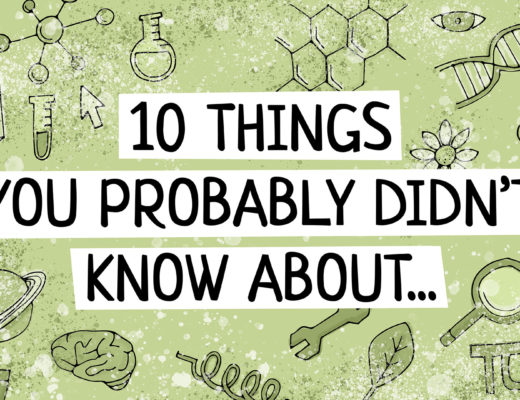Is there more to sex than you think? Sex is rather popular but how much do we really know about the birds and the bees? Here are 10 things you probably didn’t know about reproduction…
1- Amazon molly fish, named after an all-female tribe of warriors from Greek mythology, are all-female species of fish. Their eggs are “pseudo-fertilised” by the sperm of males from a different (but closely related) species. These sperm are only used to trigger the development of the embryos, and don’t contribute with any genetic information.
2- The ‘virgin birth’ isn’t just a phenomenon in religion- it’s fairly common in the plant and animal world. Parthenogenesis (from the Greek parthenos, meaning virgin, and genesis, meaning origin) is a reproductive strategy where females (rarely a male) can produce offspring without fertilisation (with either half or an entire set of their mama’s chromosomes). Originally scientists believed parthenogenesis was rare and occurred mostly in captivity or in extreme environmental conditions, but now we know it is common in many species, from plants and microscopic invertebrates to insects like ants and bees, and even some species of snakes, frogs, fishes and birds!
3- A bacteria called Rickettsia infects wasps and forces them to reproduce by “thelytokous parthenogenesis”, which is a type of ‘virgin birth’ where females produce only daughters. When scientists gave antibiotics to these female wasps (killing the bacteria), they then produced offspring that were almost all males!
4- The small Australian marsupial Antechinus has so much sex during its reproductive age that it literally dies. Sounds dramatic, but it’s true! They produce and stock all the sperm they can until they reach sexual maturity at about 11-months-old. Then, they start having aggressive, frantic sex non-stop for two weeks until their bodies simply fall apart from an immune system breakdown triggered by stress. But even though they can mate for up to 14h in a row, it’s not the sex that stresses them out- it’s the competition with the other males. Stress from the tension and fighting causes internal bleeding and many infections until they eventually collapse. This frenzied and often deadly reproduction strategy is relatively common in the animal kingdom- it’s technically called semelparity, or more colloquially ‘big bang reproduction’. Talk about explosive sex…
5- Naked mole rats live in underground colonies where there is usually only one reproductive female – a Queen naked mole rat (what a title!). This Queen naked mole rat keeps other females from becoming reproductive by releasing a chemical in her urine that makes them infertile! When the Queen dies, the remaining females fight fiercely for her crown. And then the winner gets her revenge and makes her competitors infertile. Oo ha ha HA (*evil laugh*).

6- It’s quite possible that one of the strangest looking fish in the ocean also has one of the most bizarre reproductive strategies: the anglerfish. You know, the ugly mean fish in Finding Nemo which has fangs and a sort of torch on the forehead. That’s the one- except that males look nothing like that; only females have the light bait and crazy teeth. Back to the sex part. The male anglerfish uses its well-developed eyes and huge nostrils to search for a female. He bites the female’s belly and then his mouth fuses to her body permanently. He lives the rest of his life attached to the female, supplying his sperm (NOT through the fused mouth) and sucking nutrients from her blood- a sort of twisted sexual parasitism, or “biting-fusing-mating”. Strangely enough, the females are perfectly fine after this weird love-making; they can live up to 30 years with several males attached to them!
7- Orchids are known for their strange reproduction strategies, but the Tongue orchid might take the cake. This plant is sexually deceptive – it tricks male wasps into mating with its flowers until the wasps, mmm… ejaculate. Many orchid species attract male wasps for reproduction- more wasps, more pollination. But the Tongue orchid is the only species that can trigger the males to climax. Scientists aren’t sure what the plant gains with this extreme strategy, but they know this species has the highest pollination rates. Whatever works.
8- Reproduction in the giant Amazon water lily involves beetles and a sex-change. The female flowers attract beetles with their sweet scent and high temperature (they’re weirdly warmer than the air around them) and then the flower closes, trapping the beetles covered with pollen from other flowers inside. Time for a pollination party! The next day the flower turns pink and becomes male- now producing its own pollen, which gets stuck to the beetles. Finally, the flower opens and sets the pollen-loaded beetles free to search for another female flower to pollinate. And alas, the flower dies.
9- Sex in cheese. Scientists discovered a fungus that might be getting it on in your cheese. It was thought that most fungal species reproduced without sex, but it turns out that the fungus used to make blue cheese is not only alive in the cheese, but it’s also having sex. While you’re eating it. This is good news for cheese production, because when different fungal strains have sex, they may produce new strains and new (hopefully) tasty cheeses.
10- Common Midwife toads are named for their unusual reproduction. Females expel a string of eggs that the male collects and wraps around his ankles. The male remains on land wrapped in the eggs until tadpoles have developed, occasionally dipping in water to keep the eggs moist. The male toad keeps these eggs safe for 3 to 6 weeks, until it finds its way to the water again and releases the developed larvae.
So there you go, now you know that the most exciting sex in the animal kingdom is definitely not happening in your bedroom… (no offence).
Sources:
- https://www.cell.com/current-biology/pdf/S0960-9822(07)01392-9.pdf
- https://royalsocietypublishing.org/doi/10.1098/rsbl.2012.0666
http://www.bbc.com/earth/story/20141219-spectacular-real-virgin-births - https://aem.asm.org/content/76/8/2589.full
- https://www.nationalgeographic.com/science/phenomena/2013/10/07/why-a-little-mammal-has-so-much-sex-that-it-disintegrates/
- https://www.sciencedaily.com/releases/2009/02/090224133328.htm
- https://www.wired.com/2013/11/absurd-creature-of-the-week-anglerfish/
- https://www.newscientist.com/article/dn13642-orchids-sexual-deception-triggers-ejaculation/
- https://bloomingplants.wordpress.com/2014/07/10/weird_pollination/
- https://www.smithsonianmag.com/smart-news/the-fungus-in-your-cheese-is-having-weird-sex-156095258/
- https://animaldiversity.org/accounts/Alytes_obstetricans/




